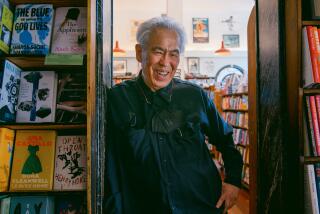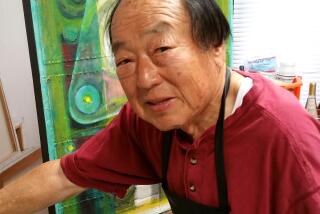Ronald T. Takaki dies at 70; pioneer in the field of ethnic studies
Ronald T. Takaki, a prolific and controversial scholar who helped pioneer the field of ethnic studies and wrote animated histories about blacks, Asians, Latinos and other marginalized Americans during four decades on the UC Berkeley faculty, has died. He was 70.
Takaki killed himself at his Berkeley home Tuesday, his son Troy said.
The scholar had struggled for nearly 20 years with multiple sclerosis, a potentially debilitating neurological disease for which there is no cure. âHe couldnât deal with it anymore,â Troy Takaki said Thursday.
FOR THE RECORD:
Takaki obituary: The obituary of Ronald T. Takaki, professor emeritus of ethnic studies at UC Berkeley, in Fridayâs Section A said he was dismissed from UCLA in 1970. He left of his own accord after being denied early tenure. â
Takaki was the author and editor of more than 20 books, including âIron Cages: Race and Culture in 19th Century Americaâ (1979),âStrangers From a Different Shore: A History of Asian Americansâ (1989), âA Different Mirror: A History of Multicultural Americaâ (1993) and âDouble Victory: A Multicultural History of America in World War IIâ (2000).
He established UC Berkeleyâs PhD program in ethnic studies, the first of its kind in the nation, and gave prestige to the program by drawing top-notch scholars to teach in it.
âRon Takaki elevated and popularized the study of Americaâs multiracial past and present like no other scholar, and in doing so had an indelible impact on a generation of students and researchers across the nation and world,â Don T. Nakanishi, director of UCLAâs Asian American Studies Center, said Thursday.
Takaki, the grandson of Japanese immigrants, was an activist as well as a scholar. He was a vigorous proponent of multicultural education and a vocal opponent of Proposition 209, the 1996 California ballot initiative that rolled back affirmative action policies in state-funded institutions.
His work often invited controversy. He earned some of his most favorable reviews for âStrangers From a Different Shore,â which covers the long history of Asian immigrantsâ odysseys to America, starting with the Chinese who arrived in the 1850s and ending with the Hmong refugees from Southeast Asia of the 1980s. âA superb balancing act,â Jon Foreman wrote in the New York Timesâ review.
But the book was roundly criticized by some Asian American studies scholars, who cited instances of alleged plagiarism and raised questions about his research methods and treatment of women. Perhaps a measure of his influence, an entire issue of the scholarly journal Amerasia in 1990 was devoted to critiques of the work. The charges of plagiarism were investigated by a UC Berkeley administrative officer, but Takaki was cleared.
His focus on the pluralism of America began in the ethnic stew of Hawaii, where he grew up. Born in Honolulu on April 12, 1939, he was the grandson of a Japanese immigrant who went to Hawaii in 1886 to work in the sugar cane fields. After his father died when Takaki was 7, he was raised by his mother and Chinese stepfather, who ran a Chinese restaurant in Honolulu.
âI grew up peeling shrimp, cutting onions and reading âMoby Dick,â â he told The Times in 1989.
Nicknamed âTen-toes Takaki,â he was a fearless surfer who was indifferent to school. But in high school a Japanese American teacher urged him to try college and wrote him a recommendation to the College of Wooster in Ohio, which accepted him. One of three children, he was the first in his family to attend college.
His years at Wooster, where he was one of two Asian Americans on campus, gave him a new awareness of himself as an ethnic American. One of his professors âasked me how long Iâd been in this country, where did I learn to speak English. I told him I was from Hawaii and he says, âBut how long have you been in this country?â I guess I didnât look American,â he recalled in an interview in the Lincoln Journal Star in 2000.
He graduated from Wooster in 1961 with a bachelorâs in history. At UC Berkeley he received a masterâs in 1962 and a doctorate in 1967 with a dissertation on the history of American slavery.
His doctoral work caught the attention of UCLA. Takaki was hired and in 1967 taught the universityâs first African American history class.
When the young Japanese American, sporting a crew cut, walked into the classroom for the first time, the students, some wearing Afros and dashikis, fell silent. One student finally spoke up.
âWell, Prof. Takaki,â the student said in a challenging tone, âwhat revolutionary tools are we going to learn in this course?â Takaki replied: âWeâre going to study the history of the U.S. as it relates to African Americans. Weâre going to strengthen our critical-thinking skills and our writing skills. These can be revolutionary tools if we make them so.â â
The class and its unlikely professor became hugely popular. âHe won the hearts of the students, the African American and the many white students who were interested in black history in those days,â recalled UCLA history professor Gary Nash.
Members of the campusâ Black Student Union, which asked Takaki to be its advisor, later joked that it was âjust like a white university to find a yellow man to teach black history,â Nash said.
Teaching the class, which drew students of various ethnicities, led Takaki to begin to reformulate race as âmore than just a binary of black and white.â It inspired him to develop a course on the comparative history of racial inequality.
UCLA dismissed him in 1970 after he openly criticized the universityâs hiring policies. He wound up at Berkeley in 1972 and taught the course there for 28 years, often turning students away for lack of seats. âIf he wanted to, he could have had 1,000 students each term,â said retired ethnic studies professor Roberto Haro, who had taught with Takaki at Berkeley.
Takakiâs first books focused on black history, such as âA Pro-Slavery Crusade: The Agitation to Reopen the African Slave Tradeâ (1971), which examined the effect of abolition on the Southâs economy.
In the 1980s he began to focus on Asian American history, such as in âPau Hana: Plantation Life and Labor in Hawaiiâ (1983). That book was his first attempt at writing narrative history, emphasizing the voices of his often obscure or unknown subjects to give âthe eye-level view of working in the cane fields, feeling the heat, breathing the red dust.â
He continued to refine that approach in later books, such as âDouble Victory: A Multicultural History of America in World War II,â which draws from letters, songs, poetry and other sources, and âA Different Mirror,â which told stories about minoritiesâ struggles, such as the Japanese and Mexican farmworkers in California who united under the same strike banner in the early 1900s.
Takaki is survived by his wife, Carol Rankin; sons Troy of Venice and Todd of El Cerrito, daughter Dana of Chester, Conn.; a brother, Michael Young, of Thousand Oaks; a sister, Janet Wong, of Chatsworth; and seven grandchildren.
A memorial service is planned at UC Berkeley at a later date. The family requests that any memorial donations be sent to the Asian Law Caucus, 55 Columbus Ave., San Francisco, CA 94111.
More to Read
Start your day right
Sign up for Essential California for the L.A. Times biggest news, features and recommendations in your inbox six days a week.
You may occasionally receive promotional content from the Los Angeles Times.







